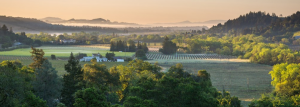In our youth, most people we knew who did drink didn’t drink wine. Oh, there would be an occasional bottle on a special occasion, but the alcoholic beverages of choice in those days were whisky and beer. Many of us were the first in our families who took wine seriously, both as an accompaniment to a meal and as a drink that would give unique pleasure on its own.
So what were we drinking back then? By our current standards, it wasn’t very good. For one thing, we were students and we didn’t have much money. Even if a Mouton Rothschild could be had for around ten dollars, that was a lot for a starving scholar then. Also, there weren’t as many wine stores such as we see today; there were liquor stores with a few bottles of red and a few bottles of white somewhere in the back. (It was a little better if you lived in an area with Italian, French or Spanish immigrants, but not a lot better.)

Photo courtesy of J. Crew
If you were anything like us, the first wine you actually went into a store and bought for yourself was one of these: Lancers, Mateus, Mouton-Cadet or Gallo Hearty Burgundy. All these wines are still available for purchase. (One of the reasons for buying Lancers was that it came in a nice clay bottle that you could use as a vase, so it maybe doesn’t count as a wine, but let’s include it.)
Lancers was and is a light bodied rosé from Portugal. Amazingly, it is produced by the great port house, Fonseca. It was created for American tastes and it succeeded quite well in that regard. Described as “moderately sweet” on the Fonseca web site, it tastes pretty sweet to us.
Its competitor for American attention was Mateus, which some of us pronounced mat-OOS and those affecting a European elegance said ma-TAY-us. We don’t think anyone knows to this day. It’s also Portuguese, sweet, comes in a pretty, mandolin-shaped bottle and was impressive to bring on a date. It showed you were too cool for Lancers, which after all had an English name.
But what could be better than a French name, and that of a French baron no less? Mouton Cadet was originally the name that the French branch of the renowned Rothschild family gave to wines it didn’t think were worthy of being called “real” Mouton. By the time we were buying it, Mouton Cadet had morphed into a thin, acidic, mass produced wine. But we liked it. Just perfect for anyone who knew nothing about wine…and that was us. By the way, these days it’s not bad for the price.
Finally, Gallo Hearty Burgundy was, as Gallo calls it today, their “original red blend” which of course had nothing to do with Pinot Noir from the east of France. But it tasted pretty good and showed your fraternity brothers that you were above (sneer) mere beer. You probably can’t do much better even today for six bucks.
Other than a nice walk down memory lane, what’s the relevance to today’s wine tasters of even moderately good taste? These wines are where we got our start. Even if they weren’t very serious wines, we took them seriously. If we’re honest with ourselves, we liked them back then although we couldn’t have said why. They brought a little glamor and sophistication into our lives and opened some horizons as to how people lived across the ocean or the continent.
In short, these wines of yesteryear were the first steps that led us to wineries in Napa Valley, Tuscany, Bordeaux and numerous other outposts in Wine Country. Sure, we can look down our oh, so elegant noses at those bottles we wouldn’t think of buying today. But consider: there’s probably some wine you like today that won’t be as appealing to you in a few years. Our tastes grow and change, and they had to start somewhere.
















